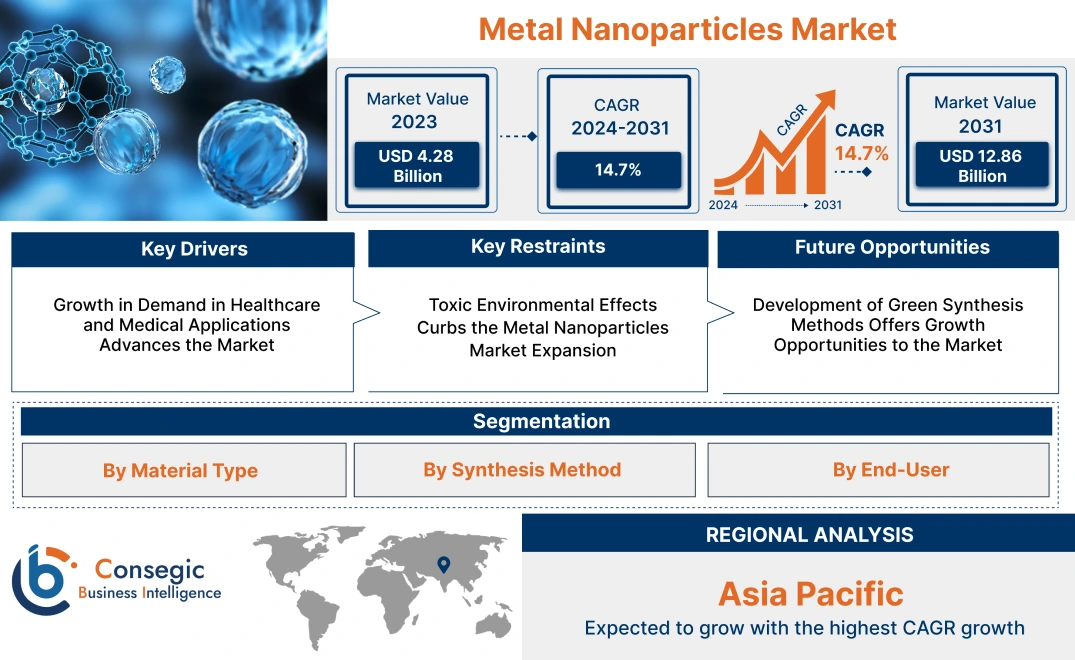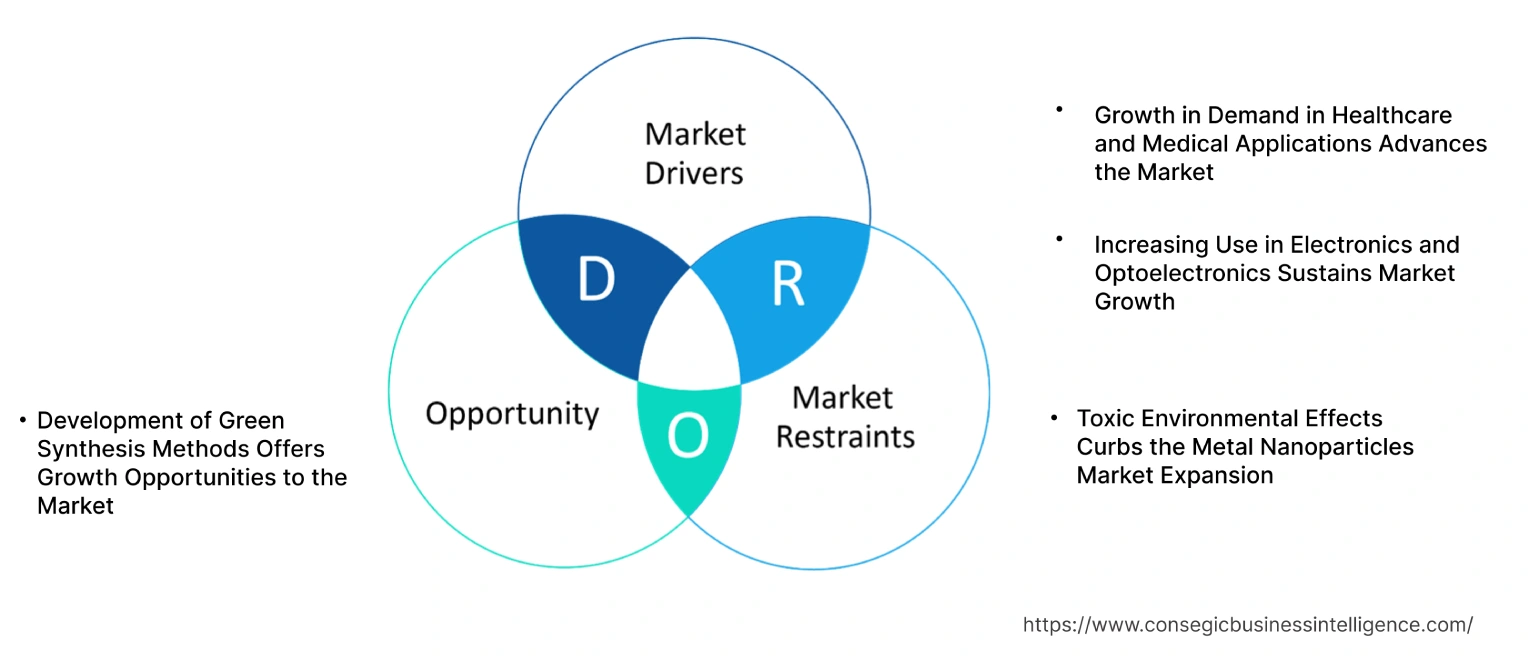- Summary
- Table Of Content
- Methodology
Metal Nanoparticles Market Size:
Metal Nanoparticles Market size is estimated to reach over USD 12.86 Billion by 2031 from a value of USD 4.28 Billion in 2023 and is projected to grow by USD 4.83 Billion in 2024, growing at a CAGR of 14.7% from 2024 to 2031.
Metal Nanoparticles Market Scope & Overview:
Metal nanoparticles are made up of metals whose size ranges from 1 to 100 nanometers (nm). These small particles showcase rare properties which makes them suitable and distinctive for various industries. One of its primary properties is its high surface area-to-volume ratio which makes them highly useful as catalysts and increases their reactivity. They also exhibit excellent optical, electronic, and magnetic behaviors. They can interact seamlessly with light, leading to impressive surface plasmon resonances. They also offer high electrical and thermal conductivity, making them suitable for efficient energy storage. The unique properties of these nanoparticles make them beneficial for imaging, therapeutic applications, chemical processes, etc. The end-users of metal nanomaterials are in sectors like healthcare and pharmaceuticals, energy systems, electronics, chemical industry, etc.
Metal Nanoparticles Market Insights:
Key Drivers:
Growth in Demand in Healthcare and Medical Applications Advances the Market
Metal nanoparticles have rare optical and magnetic properties. This makes these nanoparticles suitable for applications in the medical and healthcare sectors as they help with better visualization of cells and tissues. They also make it seamless for healthcare options to properly diagnose diseases through ultrasound techniques and bioimaging like MRIs, X-rays, etc. These nanoparticles have excellent antimicrobial properties and can be used in therapies like photodynamic therapy (PDT) or photothermal therapy (PTT). They are quick to activate and can eliminate pathogens from the body with relative ease. Certain nanoparticles like silver nanoparticles offer tissue engineering and are adept at sensing biomarkers. These nanoparticles can also enhance the sensitivity of tests, offering early diagnostics for cancer treatments.
- A study for integrating metal nanoparticles and nanobodies to advance biomedical imaging for neurodegenerative diseases was recently published in the online journal ‘Frontiers in Nanotechnology'. The researchers leveraged the X-ray attenuation of these nanoparticles and the curated targeting properties of nanobodies. This resulted in achieving specificity X-ray phase-contrast tomography (XPCT), rendering it a molecular and specified imaging method.
Therefore, the versatility and functionality of these nanoparticles are improving the medical and healthcare field thus driving the metal nanoparticles market growth.
Increasing Use in Electronics and Optoelectronics Sustains Market Growth
Metal nanoparticles have exceptional electrical conductivity which makes them suitable for integration in miniaturized circuits and other components. This enhances the productivity of consumer electronics such as smartphones, tablets, etc. They also provide flexibility which is employed in electronics with foldable screens, wearable devices, etc. In optoelectronics, they offer better light absorption and scattering. This makes them suitable for usage in solar cells, LEDs, photodetectors, etc. These nanoparticles play a crucial role in sensor technology as they can effectively react to external environmental stimuli such as heat, pressure, etc. This makes them ideal for monitoring gas leaks and detection of discrepancies in biometric systems. They are also efficient in energy storage and offer electromagnetic interference (EMI) shielding.
- In 2021, researchers from Northwestern Polytechnical University and the National Center for Nanoscience and Technology developed brand-new metal nanoparticle-based and ionic gradient transistor and logic circuits They have the capability of 400-fold intonation of electrical conductivity and offer remarkable efficiency.
Thus, as these nanoparticles are increasingly employed in optoelectronics, batteries, supercapacitors, plasmonic, and photonic devices, they offer new possibilities to sustain the metal nanoparticles market growth.
Key Restraints :
Toxic Environmental Effects Curbs the Metal Nanoparticles Market Expansion
Metal nanoparticles such as titanium dioxide, silver, etc, could enter ecosystems through wastewater or industrial discharge. Once these particles have been released they persist in the ecosystems and contaminate water bodies, soil, etc. Their nanoscale size and high reactivity are toxic to aquatic life and terrestrial organisms. They disrupt cellular functions leading to negative impacts on developmental processes. For humans, long-term exposure to these nanoparticles could lead to chronic illnesses, respiratory problems, etc as they can delve deep into the lungs when inhaled.
- In 2022, an article published on ‘Frontiers in Nanotechnology' discusses the toxic effects metal and metal oxide nanoparticles have on the environment. It highlights how these nanoparticles could release intracellular metal ions which can lead to mitochondrial dysfunction.
Thus, as per analysis, the risk these nanoparticles pose to biodiversity and ecosystems has raised concerns about their usage in consumer products and industrial applications. This curbs the metal nanoparticles market demand.
Future Opportunities :
Development of Green Synthesis Methods Offers Growth Opportunities to the Market
Green synthesis of metal nanoparticles employs eco-friendly and non-toxic raw materials, such as plant extracts, biodegradable polymers, microorganisms, etc for the manufacture. This lowers the carbon footprint as there are less hazardous byproducts and no detrimental solvents. They produce biocompatible metal nanoparticles that can be safely employed in industries such as biomedical, agriculture, personal care, etc. Green synthesis methods are also less expensive, creating an incentive for manufacturers to adopt this method.
Thus, manufacturers opt for a sustainable synthesis method that is cost-effective too, broadens the market applications of these nanoparticles. This opens up fresh metal nanoparticles market opportunities.
Metal Nanoparticles Market Segmental Analysis :
By Material Type:
The market is divided based on material type into Gold, Silver, Platinum, Copper, Nickel, and others.
Trends in the Material Type:
- Gold nanoparticles are being adopted for photothermal therapy (PTT) as they can absorb light faster and convert it into heat.
- Metal nanoparticles can now be targeted to lower the damage to healthy cells by leveraging their external magnetic fields.
The gold segment accounted for the largest revenue in 2023.
- Gold nanoparticles are biocompatible and can be functionalized for particular biological interactions, such as drug delivery or diagnostics.
- These types of nanoparticles have high conductivity, stability, and corrosion resistance. This makes gold nanoparticles important in the manufacturing of electronic devices like circuits, conductive inks, etc.
- They are excellent catalysts and are used in oxidation-reduction reactions.
- For instance, a group of researchers from the University of Tokyo developed ultra-stable and extremely reactive colloidal gold nanoparticles. These advanced gold nanoparticles can handle a greater range of physical stimuli, enhancing their properties as catalysts.
- Thus, as per metal nanoparticles market analysis, gold nanoparticles inherently have a high market value resulting in larger revenue generation.
Silver is expected to have the fastest CAGR during the forecasted period.
- Silver nanoparticles have strong antiviral, antibacterial, and antifungal properties. This makes them suitable for use in the healthcare sector. For example, due to its antimicrobial properties, silver nanoparticles are used in wound dressings and hygiene products.
- They are also used in consumer products such as personal care items, cosmetics, clothing, etc.
- Due to their conductive properties, are employed in flexible displays, printed electronics, etc.
- They are more versatile and cost-effective than gold nanoparticles, whilst providing similar properties to gold for many applications.
- Therefore, as ongoing research trends in nanotechnology increase, silver nanoparticles will hold the position of the fastest CAGR in the future.
By Synthesis Method:
The market is divided based on its synthesis method into Chemical Vapor Deposition (CVD), Sol-Gel Method, Electrochemical Synthesis, Laser Ablation, and others.
Trends in the Synthesis Method:
- Green synthesis is now making the production and adoption of metal nanoparticles attractive to manufacturers as they are cost-effective.
- Now, bioremediation is possible to create biogenic metal nanoparticles for removing heavy metals from contaminated water bodies.
Chemical Vapor Deposition accounted for the largest revenue of 30.52% in the metal nanoparticles market share in 2023.
- Chemical vapor deposition (CVD) results in the synthesis of metal nanoparticles with high uniformity and purity.
- It is a scalable synthesis method that allows mass production of these nanoparticles. Large volumes of metal nanoparticle production lead to its cost-effectiveness, unlike other synthesis methods.
- It can be employed to deposit a wide range of metal nanoparticle material types, such as gold, silver, copper, etc. This versatile nature of the CVD process is preferred in industries such as energy storage, electronics, etc.
- This synthesis method can be curated and adapted to lower environmental impacts by reducing energy consumption and producing less hazardous by-products.
- Therefore, as per the analysis, the CVD synthesis method can be applied in various industries and enables sustainable manufacturing, thus boosting the metal nanoparticles market demand.
Sol-Gel Method is expected to have the fastest CAGR during the forecasted period.
- The Sol-Gel method where a solution is transitioned into a solid (gel) to form thin films, is a cost-effective synthesis method. This involves an easy solution-based chemistry and uses less expensive raw materials.
- Compared to other synthesis methods, such as CVD, the sol-gel method requires less temperature to operate. This offers greater compatibility with temperature-sensitive substrates, making this method highly versatile.
- The sol-gel method ensures precise control over the structural composition such as the shape and size of these nanoparticles. This is important in industries where high-quality performance depends on nanoparticle structure.
- This method is eco-friendly as it uses alcohol or water as solvents making it an attractive and sustainable production process for industries with growing environmental conscience.
- For instance, a study on the synthesis of metal oxides NP through the sol-gel method was conducted and its biomedical applications were discussed. The characteristics of the metal nanoparticle's chemical structure were studied and their efficient employment in therapeutic processes was underscored. The concluding research findings determined the pattern of X-ray diffraction (XRD) and the subsequent formation of the nanoparticles.
- Thus, as per the analysis, the growth in the sol-gel method of synthesizing method is in demand in various sectors due to its flexibility, thus in turn driving the metal nanoparticles market trends.
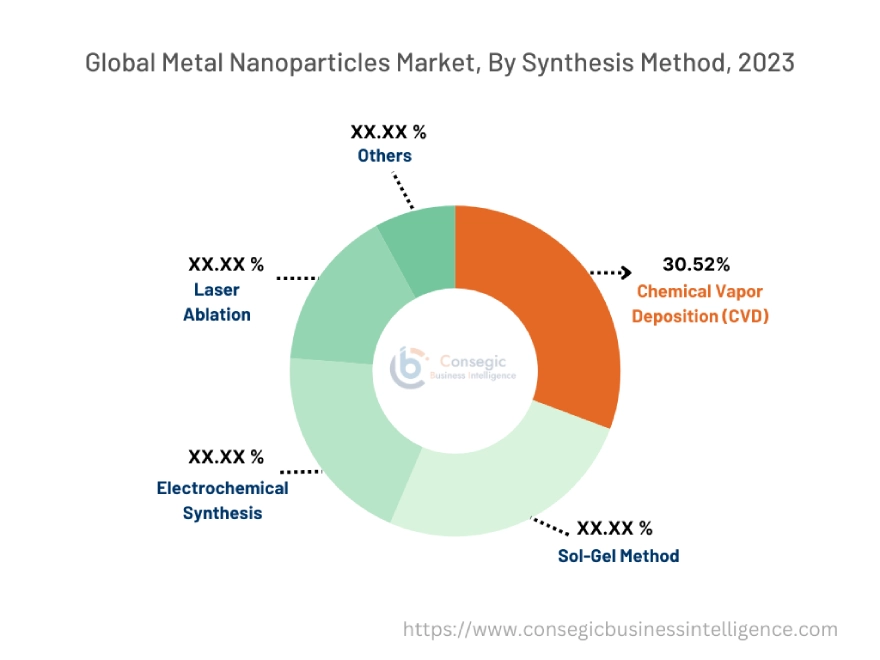
By End-User:
The market is divided based on end-users into healthcare, electronics, energy, textiles, cosmetics, and others.
Trends in the End-User:
- Metal nanoparticles enhance the durability and performance of semiconductors and other variables that are used in 5G networks.
- There is an increase of using these nanoparticles which are synthesized through green methods in the food and beverage packaging sector.
Healthcare accounted for the largest revenue in the metal nanoparticles market share in 2023.
- Metal nanoparticles like gold or silver are extensively used in the healthcare sector for drug delivery, cancer therapy, etc. Their nanoscale size and rare chemical properties make them ideal for biomedical interactions in innovative ways.
- Their improved sensitivity and precision of diagnostic methods in medical fields are leveraged to be used in biosensors and contrast agents in bioimaging like CT scans, for greater detection and disease monitoring.
- Certain nanoparticles, like silver, are highly antimicrobial, making them suitable for coatings and preventing infections.
- These nanoparticles are studied for new regenerative medicines such as in the development of scaffolds for tissue engineering, as the field of nanomedicines experiences expansion.
- Therefore, as per the analysis, the healthcare sector has expanded its use of metal nanoparticles, which led it to have the largest revenue share in this market.
Electronics is expected to have the fastest CAGR during the forecasted period.
- The demand for smaller and more compact electronic devices is being met by metal nanoparticles. They offer exceptional electrical and thermal conductivity that allows the development of smaller, energy-efficient electronics.
- Nanoparticles like silver are used in printed electronics for the production of RFID tags, flexible electronic components, and wearables.
- They can improve data storage capacity as well as speed. This makes them crucial in the development of advanced computing techniques, like quantum computing.
- They offer the use of less material without compromising high-quality performance. This makes them sustainable and resource-efficient.
- Thus, as ongoing research and development studies the potential of nanoparticles in electronics, this segment will have the fastest growth in the future. That in turn drives the metal nanoparticles market trends.
Metal Nanoparticles Market Regional Analysis:
The regions covered are North America, Europe, Asia Pacific, the Middle East and Africa, and Latin America.
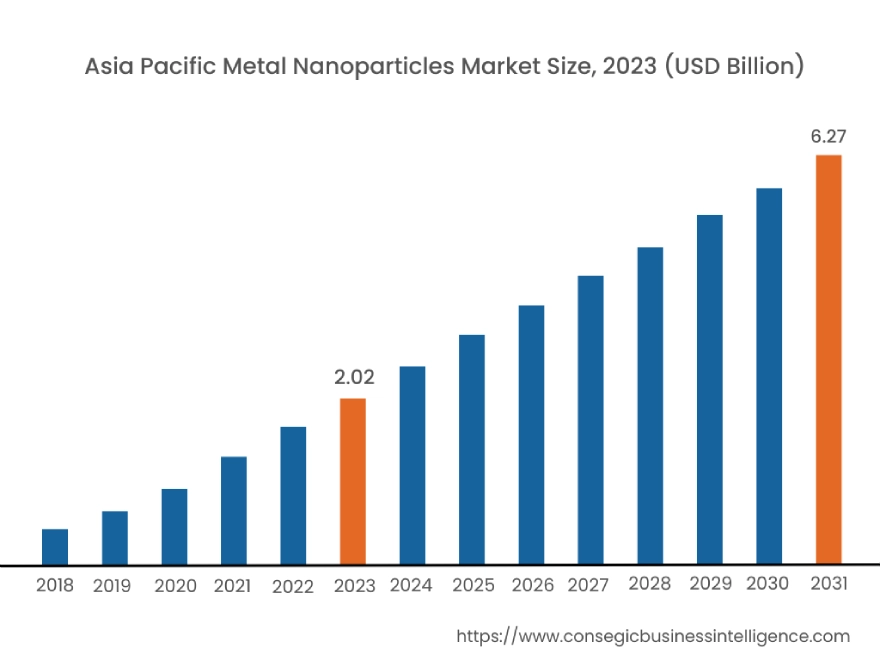
Asia Pacific region was valued at USD 2.02 Billion in 2023. Moreover, it is projected to grow by USD 2.29 Billion in 2024 and reach over USD 6.27 Billion by 2031. Out of this, China accounted for the maximum revenue share of 41.6%.
Asia Pacific region has a growing trend to focus on the use of nanotechnology electronics and the semiconductor industry. In nations like China, Japan, South Korea, etc. there has been rapid urbanization which provided them with the provisions to establish themselves as global hubs of electronics manufacture. These nanoparticles are essential for developing high-performance sensors, semiconductors, microchips, etc. This has driven the metal nanoparticles market expansion in the region.
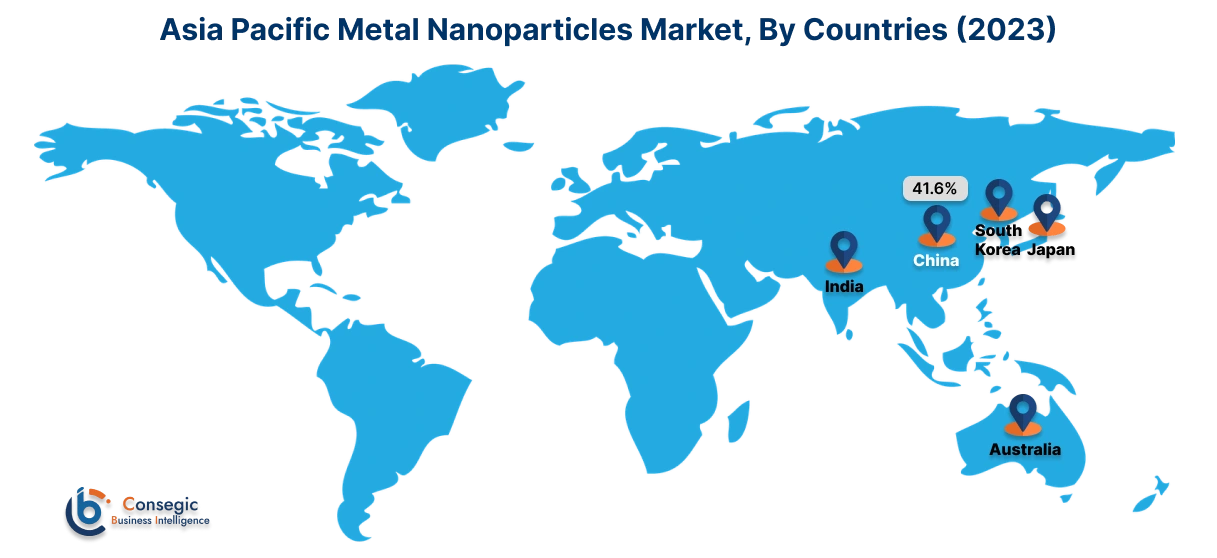
North America is estimated to reach over USD 3.19 Billion by 2031 from a value of USD 1.07 Billion in 2023 and is projected to grow by USD 1.21 Billion in 2024.
In North America, particularly in Canada and the US, there is a veritable base for research and development (R&D) in nanotech. The governments in these nations have made impressive investments in nanotech studies and building strong infrastructure for nanotechnology development too. Through public and private partnerships, commercializing initiatives, and R&D funding, they drove innovation in sectors where nanotech was employed.
In Europe, the trend of achieving sustainable and eco-friendly technologies is strongly based. These nanoparticles which are synthesized through green synthesis methods offer energy-efficient and renewable solutions. The Middle East and Africa (MEA) has a robust oil and gas industry. These nanoparticles due to their progressive chemical properties aid as a catalyst for reactions and water treatments increasing oil recovery rates.
The metal nanoparticles market analysis depicts that Latin America, especially Brazil, Argentina, etc experienced an expansion of their healthcare and medical sectors because they integrated nanotechnology into this sector. This laid the base for the demand for these nanoparticles in targeted drug delivery, development of medical devices, diagnostics, etc.
Top Key Players & Market Share Insights:
The Metal Nanoparticles Market is highly competitive with major players providing products to the national and international markets. Key players are adopting several strategies in research and development (R&D), product innovation, and end-user launches to hold a strong position in the global metal nanoparticles market. Key players in the metal nanoparticles industry include:
- Cerion, LLC. (US)
- BBI Solutions (UK)
- Merck KGaA (US)
- Ascensus
- Black Pig Ltd (UK)
- Tanaka Holdings Co. Ltd (Japan)
- US Research Nanomaterials Inc. (US)
- nanoComposix(US)
- Avansa Technology & Services (India)
- American Elements. (US)
- Nanoshel LLC (US)
- Meliorum Technologies Inc. (US)
- Hongwu International Group Ltd (China)
Recent Industry Developments :
Product Launches:
- In March 2024, a group of researchers from the Università Politecnica delle Marche and TU Wien announced the development and launch of a new variant of titanium oxide nanoparticles. This is a self-cleaning paint, due to the nanoparticle's photocatalytic properties and has commercial uses. This wall paint cleans the air too.
Mergers and Acquisitions:
- In March 2024, Nano Dimension Ltd announced the acquisition of Desktop Metal Inc. This agreement will allow the former company (Nano Dimension) to acquire the outstanding shares of the latter company (Desktop Metal) in an all-cash venture at $5.50 per share price.
Partnerships and Collaborations:
- In August 2024, the University of Sussex signed a partnership with Advanced Material Development (AMD) for a 10-year collab. This strategic deal is aimed at developing and commercializing nanomaterials and inks for various applications such as wind turbines, electric vehicles (EVs), etc. The introductory investment amount is £2.6 million over the course of the first three years. This collaboration would enhance sustainable techs like conductive inks.
Investments and Funding:
- In February 2024, the Cornell Center for Materials Research (CCMR) announced its new funding project, the JumpStart Program. Through this initiative, the institute selected three small business projects to fund for their Spring semester. One of the funded projects would assist with understanding the characteristics of metal nanoparticle nanomaterials, their structure, and their distribution with electron microscopy. It would also study its particle size and purity through Raman spectroscopy.
Metal Nanoparticles Market Report Insights :
| Report Attributes | Report Details |
| Study Timeline | 2018-2031 |
| Market Size in 2031 | USD 12.86 Billion |
| CAGR (2024-2031) | 14.7% |
| By Material Type |
|
| By Synthesis Method |
|
| By End-User |
|
| By Region |
|
| Key Players |
|
| North America | U.S. Canada Mexico |
| Europe | U.K. Germany France Spain Italy Russia Benelux Rest of Europe |
| APAC | China South Korea Japan India Australia ASEAN Rest of Asia-Pacific |
| Middle East and Africa | GCC Turkey South Africa Rest of MEA |
| LATAM | Brazil Argentina Chile Rest of LATAM |
| Report Coverage |
|
Key Questions Answered in the Report
Who are the major players in the metal nanoparticles market? +
The major players in the market include Cerion LLC (US), BBI Solutions (UK), Ascensus(US), Merck KGaA (US), US Research Nanomaterials Inc. (US), nanoComposix (US), Avansa Technology & Services (India), Black Pig Ltd (UK), Tanaka Holdings Co. Ltd (Japan), American Elements. (US), Nanoshel LLC (US), Meliorum Technologies Inc. (US), and Hongwu International Group Ltd (China).
What specific segmentation details are covered in the metal nanoparticles market report? +
The metal nanoparticles market is segmented into, material type, synthesis method, and end-user industry.
Which is the fastest-growing region in the metal nanoparticles market? +
Asia Pacific is the fastest-growing region in the metal nanoparticles market.
